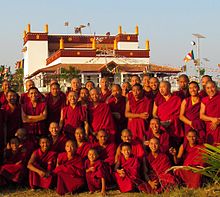Rato Dratsang
| Rato Dratsang | |
|---|---|

Some of the Rato monks in front of the temple at Rato Monastery, January 2015
|
|
| Monastery information | |
| Location | Currently in the Tibetan Settlement, Mundgod, Karnataka, India (before 1959 near Lhasa in Tibet) |
| Founded by | Tak Pa Zang Bo |
| Founded | 14th century |
| Type | Tibetan Buddhist |
| Sect | Gelug |
| Head Lama | Currently (2015) is Ven. Khyongla Rato Rinpoche |
| Number of monks | Previously 500, in 2014 over 120 |
Rato Dratsang (Dratsang in Tibetan means school or university), also known as Rato Monastery (sometimes spelled Ratö Monastery), is a Tibetan Buddhist monastery or monastic university of the Gelug or "Yellow Hat" tradition. Rato was, for many centuries, one of the major monastic colleges in Tibet.
The 5th Dalai Lama, Ngawang Lobsang Gyatso (1617–1682), called Rato Monastery the "Tiger Nest". The monastery served as a center for the study of logic; monks from many other monasteries came to visit Rato every year to study formal Buddhist logic intensively, and debate rigorously.
After 1959, Rato Monastery was reestablished in the Tibetan Settlement at Mundgod, in Karnataka state in south India. In recent years a charitable foundation (a 501(c)(3) organization) was set up to help the monastery flourish and grow. In 2012, a westerner monk, Nicholas Vreeland, was appointed as the new abbot.
Rato Monastery was founded in the 14th century by Tak Pa Zang Bo, on the outskirts of Lhasa, the capital city of Tibet.
During the 17th century, the Great Fifth Dalai Lama called Rato the "Tiger Nest", commenting in verse:
Venerable Khyongla Rato Rinpoche, (born in 1923), who is the head lama of Rato, studied at the original Rato Monastery when he was a young monk. In 1959, before the Tibetan diaspora started, about 500 monks studied at Rato.
After the diaspora had started, in 1983 a small version of Rato Monastery was established in the Tibetan Settlement near Mungod, in Karnataka, India. At that point the monastery comprised a temple, monks' room, and kitchen, all in a two-storey building on one quarter-acre of land. Over time, more land was gradually acquired by being purchased from surrounding farmers. In 2008, a plan was devised for several much larger buildings, using local building materials and low-cost sustainable technologies. As the money was raised, the buildings were gradually constructed.
...
Wikipedia
